Most of us loved winter as children – think of all those happy times you spent making snowmen, lying in the snow creating snow angels and all those lovely, crisp, winter walks breaking the ice and throwing snowballs. But do you ever think about how you can help nature in winter?
Whilst we as humans can return to a cosy, warm house after enjoying the outdoors, our British wildlife is not so fortunate and winter can often mean a life-and-death struggle many; food supplies become scarce and there can often be little respite from the biting-cold weather.
However, this can be a perfect time to help other creatures and also teach any children you have or care for about seasons, ecosystems and the part humans can play in helping conserve our wildlife. So here are a few fun and practical things you can do as an individual or a family to help our insect, furry and feathered friends survive the winter months.
1. Feed the birds
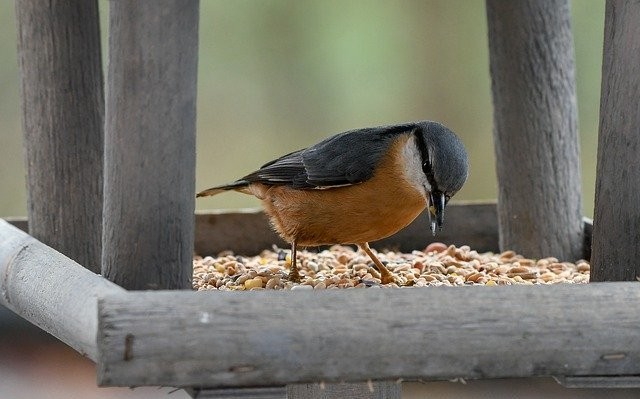
In “Mary Poppins”, feeding the birds costs ‘tuppence-a-bag’. Nowadays, it can cost a great deal more than that if you visit your local garden centre! However, you can still feed the birds quite inexpensively using nuts, dried fruit, breadcrumbs, scraps and leftovers.
- Why not make some homemade fat balls and hang them from trees or put them on a bird table? You’ll find a great free recipe here or create your own. The RSPB also has a lot of information about feeding and making feeders. You can also buy these things in their shop.
- Whilst you can buy commercial bird feeders to help our feathered friends, it’s also a lot of family fun to make your own, and you can recycle your old plastic bottles at the same time too. Using a plastic bottle with a screw top, cut a small hole in one side of the bottle so that the birds can reach the seeds. Tie some string around the neck of the bottle so that you can hang them up. Use an old pencil or skewer to pierce through the bottle so that the birds can perch either side of the hole. Make sure you keep the bottle clean by cleaning it at least once a fortnight using a mixture of 2:1 hot water and distilled white vinegar. Rinse and dry it thoroughly before refilling it with a suitable seed mix and watch the birds return to your garden.
- It’s also important to remember the ground feeding birds too. Blackbirds, chaffinches and thrushes cannot cling onto feeders as easily as blue tits or other tit species and they prefer to feed on the ground. You can buy ground feeding trays or simply scatter some seed around on an old tray or plate.
- My own children love to watch the birds feeding and we often extend this activity by doing a bird count. A good idea is to keep a diary, or even create a wall chart and keep a tally of the birds you have seen on your feeders.
2. Create a bug hotel
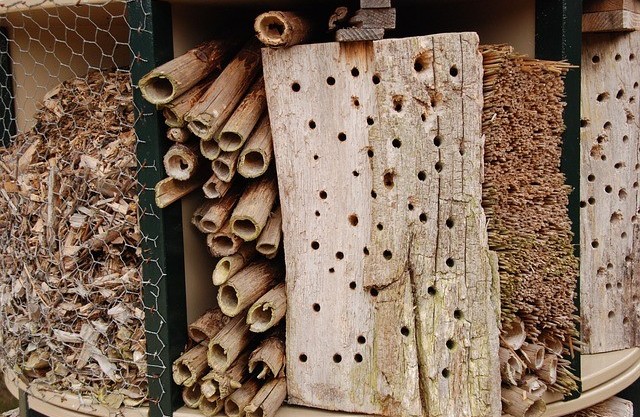
Insects need places to stay in the cold winter nights and many insects such as bees hibernate for the winter so it’s important to make space in your garden for them too. A perfect way to introduce this to children (or anyone for that matter) is to make a bug hotel in a corner of your garden. You can use whatever material you have to hand such as corrugated cardboard, old bricks, decaying leaves, twigs, sticks, rotting wood and fallen branches to create some first-class, ideal accommodation for insects, mini-beasts, spiders, and bees. You don’t need to build ‘The Savoy’ unless you want to, but just make something as small or large as your garden or resources allow. Try to position it in a sheltered area of your garden or hang a ready-made small house on a smaller patio, roof terrace or balcony. You’ll be helping the insects and creating a space for wildlife too.
3. Help a hedgehog!
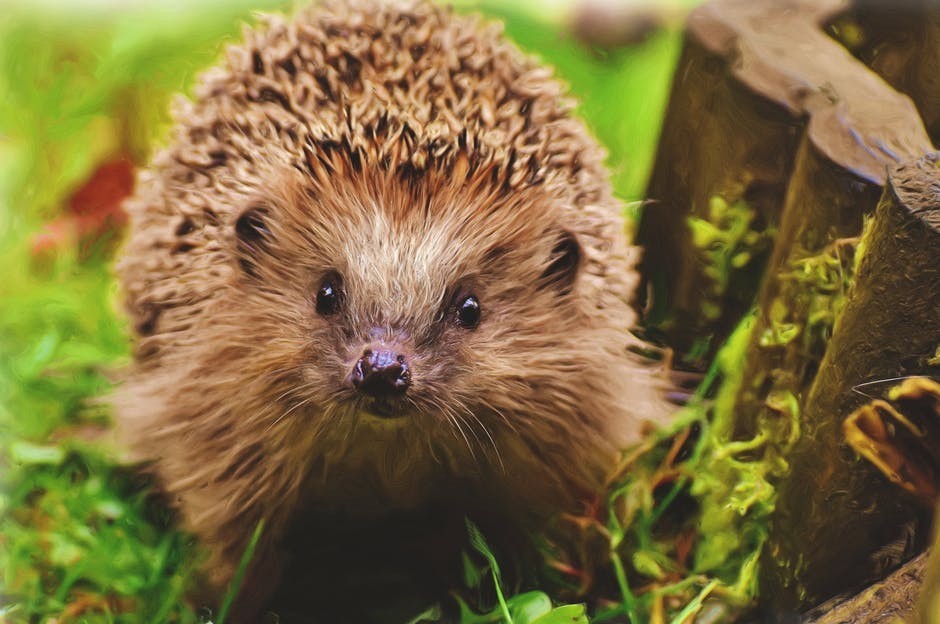
I don’t know anyone who doesn’t love hedgehogs but sadly, in the last 10 years in the UK, the hedgehog population has declined by a third. Estimated numbers are now less than one million in the UK and worldwide, the picture is similar of declining habitats and suitable hedgerows and roads threaten their existence.
People often think that if an animal hibernates then it sleeps for months without needing anything, but despite hibernating, hedgehogs still need access to shelter, and regular food and water to survive the winter. It’s also important to raise awareness of the plight of these little creatures so if you have children, you could consider some of these activities to help:
- Read your children stories about hedgehogs and talk about them. There are some wonderful stories out there such as, “The Tale of Mrs. Tiggy-Winkle” by Beatrix Potter, and “The Hodgeheg” by Dick King-Smith. There are also some free, online, educational stories about “Harry the Hedgehog” you can access here.
- Little hands can look just like a hedgehog, so why not create some hand-print artwork to stick on the fridge or your display boards? You can add a cute nose, eyes and a smile too!
- Hedgehogs need to eat too and you can buy hedgehog food at local garden centres but it’s also fun to make your own home-made ‘hedgehog-food-cakes’. Mix together some meat-based cat or dog food with some crushed up cat biscuits and dried mealworms (they love these). To encourage your nightly visitors, leave the food outside making sure you only leave enough for one day. This is to prevent attracting other unwanted pests such as rats. If you have a lot of local cats who would also love your generosity, use a strong cardboard box or old plastic storage box and cut a small hole in the side, only big enough for the hedgehogs and not the cats!
- Place a hedgehog home in your garden. You can buy commercial ones at various outlets, but you can make your own using an old, upturned plastic box with a hole cut in the side as above. Cover it with twigs, leaves or fallen branches to camouflage it and remember to site it in a sheltered area too. If you want a free fact sheet about how to make one, see the Wildlife Trust for more information on easy-to-build hedgehog homes.
4. Become a water monitor!
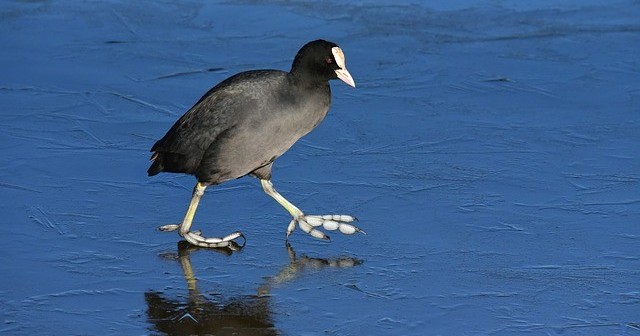
Finally, in winter, all wildlife needs to access clean, unfrozen water. But whilst there is often increased rainfall in the winter, the water often quickly turns to ice as temperatures plummet, making it unavailable for wildlife. Try to provide a source of clean water every day for the wildlife that visits your garden, and as with the birds,
- Use shallow bowls or old food containers as water stations and remember to refresh the water a couple of times a day to make sure it doesn’t freeze. You could create a water-monitoring wall chart if you have children and get them to add stickers each time you/they check the water availability or refill it. (It’s a good reminder for you too!)
- If you have a pond, it can freeze over in winter which reduces the oxygen in the water affecting fish or other pond creatures. To combat this, melt a small section of the ice every day to help maintain the oxygen levels. But do this carefully, especially if you have fish – fish will be scared by loud bangs on the top of the ice, so avoid using a stick or hammer to bash the ice. Instead, pour a small amount of boiling water from a kettle to create the hole. And if you do have children, then they usually love watching the ice melt and it’s a great opportunity to introduce them to the notion of the changing state of water too. Any openings you create in your fence will be valued by other garden visitors too, such as birds and small mammals, but ensure there is always a way for animals to climb out of a pond by positioning a plank or large branch at an angle from the water onto the bank so they can safely get out.
Whatever you can do to help wildlife this year, be sure that they will appreciate your efforts. The animals were here long before us humans, so let’s not forget them this winter.
RELATED ARTICLES
Fun activities for a rainy day: classic board games
Fun kids games: remember these?

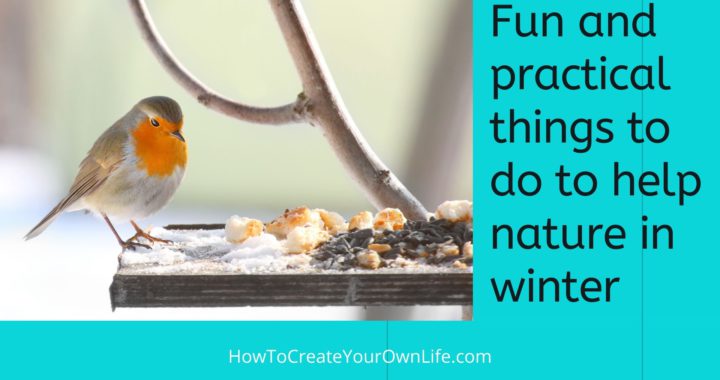
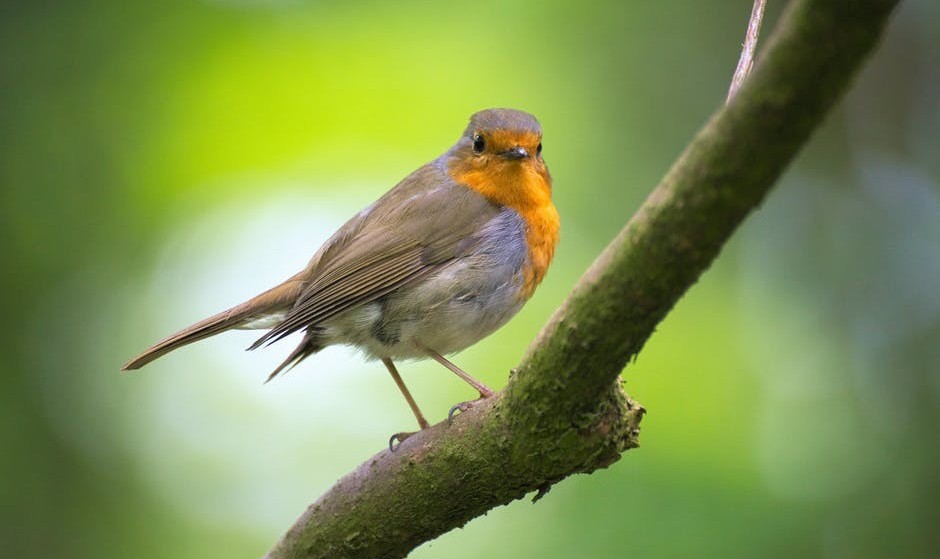



I really love the overall idea youve got here! This is such a great list of things to do for people who really care about their surroundings, and bettering the life around them. A bug hotel sounds so interesting and unique! What a fun way to be useful to nature! What is your favourite thing to do to care for nature, at other times of the year?
Hi Sonia. Thanks for reading and leaving a comment. I have several bug hotels in my garden – some of them are just because I haven’t got around to clearing things up yet, but that still counts! 🙂 My very favourite thing is feeding our 2 local hedgehogs who come out after dark and scurry around the feeder we have set up. My children also love watching them and we first noticed them as we came home one night, and one was curled up in the porch!
Hey Gail, Thank you for writing on Fun and practical things to do to help nature in winter. I learn lot from your post while reading. Your guide is very practical and anyone can follow like me. We will create a bug hotel for bees. I found the importance of having a bug hotel via your post. You are doing an awesome work by guiding people about fun and practical things we can do to help nature in winter. Keep this great work up.
Hi Parveen. Many thanks for your kind words and I’m pleased it has inspired you to create a bug hotel – they really are very easy to make and the bees need all the help they can get at the moment as their populations are declining which is not good for them, but really not good for us humans either, since we depend on them to survive! Hope it all goes well and let me know if you see any other wildlife in your own garden, wherever that is. Gail
What a fun article! I love nature and you listed some great ways to not only watch, but interact with nature during the winter months. I’m curious if you’ve created a bug hotel in the past? If so, do you have a larger infestation of bugs during the spring and summer months once they’ve come out of hibernation? I love feeding birds, helping hedgehogs, and providing water, but the thought of creating a hotel for bugs.. ack!
Hello Jasmin. Thanks for your comments and I’m so pleased you are helping your in your locality too. To answer your question, yes, I have several areas of the garden where there is a bug hotel but I have only noticed a positive benefit. The reason is really due to the circle of life and the food change. By helping the little fellows at the bottom, you end up helping the birds at the top because there are more natural food sources for them. And more spiders to catch flies, and more woodlice to feed the hedgehogs….you get the idea. It’s all about balance and restoring the natural balance of the area in which you live. Humans have taken over the planet and destroyed a lot of natural habitats for animals and insects. What we are trying to do now is restore that balance in whatever way we can. A bug hotel is a small start. Let me know how you get on. Gail
One thing that’s on my bucket list is to actually see snow! I live in a tropical place where is mostly summer all year minus some parts of December-February, but still the temperature never goes below 70°. There is a bird nest in my house though, the birds themselves made it and whenever a new egg was laid we used to watch the nest as the mother went out for food. I witnessed two birds crawling out their eggs just in time as the mother came back with some more branches with her. It’s been two years since that and the birds that were born there still come over for some bread-crusts. Nature is fully amazing and teaching children from a young age how to take care of our surroundings is something that more parents should do. We’re not only saving nature, but ourselves in the process as well.
Hi Stephanie. I totally agree with you about teaching children to live in harmony with nature – after all, they were all here first! Living in the tropics sounds like fun too and I’m sure there are challenges that your local wildlife faces that you can help with too, It might not be snow, but there will be times when they need your help too. I hope you get your wish to see snow at some point too. Have you thought about using the law of attraction to help or attract more money? Why not read my article about ithere to give you a head start?
What great ideas! I’m not in the UK, but we get cold winters here in Ohio. Now I’m looking forward to making a bug hotel. It looks like so much fun. I know you’re on a different continent, but is there any type of wood I should avoid? How high up should I make it? We sometimes get woodpeckers. They’d love the hotel.
Hello Cathy. Thanks for your comments, and lovely to make your acquaintance from ‘across the pond’. (Although it’s quite a big ‘pond’! That doesn’t matter of course, and these ideas work just as well all over the world. My suggestion is to stick with the woods that are local to you if you can. I live around lots of oak and pine trees so my bug hotel includes piles or pinecones and acorns which create spaces for the insects. Use what is around you as that is what your local wildlife will be expecting and used to. It’s also cheaper if you go to your local park and collect some fallen branches and leaves – my kids love doing this too. Hope it goes well and look forward to hearing more. Gail
I really like your approach to these tasks by getting children involved in the process. Nature is a wonderful thing to behold and people. both children and adults, can find such wonderment by just observing how they interact with their surroundings.
I personally love feeding birds and watching how some will gather the food and fly off to a nearby tree only to return again for more. Then there are those who will eat right where the food is. I often feed birds from what I have in my kitchen like seeds and bread.
I do not have much of a yard to work with seeing how I live on the first floor of an apartment complex, but there is a small grassy lawn just outside my kitchen window. Water is not something I have considered. Do you have any ideas for a water trough or container I could hang from my window sill?
Hi Robert. Thanks for your interest in the article and taking the time to reply. I’m glad you like feeding the birds – that’s one of my favourite things to do as well. You can buy some water dispensers to hang on your balcony or you can make your own by upturning an old plastic bottle and attaching a small side plate to the bottom. You can also just place a small shallow bowl of water on the balcony and you’ll probably find the bids use it as a birdbath too. Let me know how you get on and whatever you do, thanks for helping out the wildlife near you.
Hiya Gail
Thank you for your great article on fun and practical things to do to help nature. I have to be careful at home, my 8 year old made a fatball with her pal for the birds that visit our garden but I had to give it to someone else because 3 cats live here and they love to kill and play with birds. They don’t eat them and they killed a baby bird I tried to protect because it had a bad wing. Hedgehogs fare a bit better as they have spikes, I’d love to set some of the wee hedgehog houses up with my cubs but I think they might have to fight the cats for their food!
Are hedgehogs useful in nature or just cute? What are mealworms? They sound gross! I have an outdoor camera that I really need to set up so I can see what the wildlife are up to in my garden at night. I see frogs and toads occasionally and wonder where they come from and how they get in. Do birds drop them, do you think? The nearest water is the burn and it’s a bit of a hop to here!
Thanks for some interesting things to think about and do, krs PurpleLioness
Hi PurpleLioness. I love your name, by the way! Thanks for taking the time to read and reply and I totally understand the problems of feeding the birds and having cats. I have 2 cats as well, and we have nesting starlings and sparrows very close to our house so I have to be vigilant. Fortunately, the cats are getting older and lazier now, so prefer not to go out when it’s too cold and chasing things is now getting to be too much trouble!
To answer you question about hedgehogs, they are extremely useful iln the garden, keeping the balance as they eat a lot of slugs, caterpillars, insects and worms which can often decimate garden crops if not kept in check, so hedgehogs are a great and organic way to deal with these pests. Mealworms are really just dried up small worms and they are a favourite food of reptiles, birds and hedgehogs as they are rich in protein. Your frogs and toads will love these too. I think they would be too heavy for most birds to drop. Many frogs and toads especially are nocturnal, because the sun dries up their skins, so they come out at night more. It’s also likely that you see them during their mating season when they will come out of the damp undergrowth after hibernating to find a mate. I used to live in a place where the locals used to come out in force to help the local toads to migrate across the roads because too many of them were being squished! They used to go out with torches to help them safely from one side to the other and to get the drivers to slow down – it worked!
I love the idea of you setting up a camera to catch the wildlife. Let me know how it goes. Gail